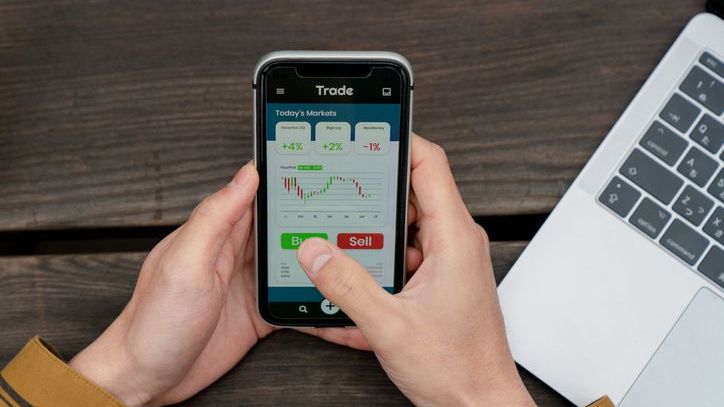Fractional shares allow investors to purchase a piece of a stock or exchange-traded fund (ETF), even if they can’t afford a whole share. Fractional share trading is a lot like buying and selling whole shares of stock, requiring you to open a brokerage account, research potential stocks and then placing your order. If you’d rather have an expert select and manage your investments, consider working with a financial advisor.
What Are Fractional Shares?
If the price of owning shares in a popular company is too expensive for you, buying fractional shares could be an alternative solution.
Fractional shares are essentially portions of a single stock share, representing a slice of equity in a company that is less than one full share. They allow individual investors to own stakes in companies with high share prices, which would otherwise be inaccessible due to financial constraints.
When a stock share is divided into smaller units, it becomes accessible for investment at a fraction of the cost of a full share. Brokerage firms facilitate this division by allowing the purchase of stock in dollar amounts rather than share quantities. For instance, if a company’s stock is trading at $1,000 per share and an investor wishes to invest $100, they can acquire 0.10 of a share. This process permits more precise investment amounts, enabling investors to allocate their funds with greater precision. It also allows them to capitalize on investment opportunities that would be unattainable due to prohibitive share prices.
Where Can You Buy Fractional Shares?

Accessibility and purchase options for fractional shares have expanded with the advent of online brokerage platforms. Platforms such as Robinhood, Charles Schwab, Fidelity and E*TRADE have made purchasing fractional shares increasingly available to the average investor.
For example, an investor with an interest in owning a part of Apple, a company known for its high share price, can now invest a specific dollar amount, such as $500. Through an online brokerage, the investor can buy fractional shares equivalent to their $500 investment, irrespective of Apple’s current full share price.
The transaction process is user-friendly. The investor simply logs into their brokerage account, searches for Apple’s stock, enters the desired investment amount, and executes the purchase. As a result, a fraction of Apple’s stock gets added to their investment portfolio, allowing investors to buy high-value stocks.
Who Buys Fractional Shares?
Fractional shares are particularly appealing to several types of investors:
- Beginners: Those new to investing who wish to start small and learn as they go.
- Small-budget investors: Individuals who want to invest but may not have large amounts of disposable income.
- Diversification seekers: Experienced investors looking to diversify their portfolio without committing large sums to each stock.
- Aspirational investors: Investors aiming to hold stakes in companies with high share prices, like Chipotle or Coca-Cola, without needing to invest hundreds or thousands of dollars per share.
How to Buy Fractional Shares
Buying fractional shares is a straightforward process – not unlike buying whole shares – often facilitated by online brokers. Here’s a step-by-step look at how to buy fractional shares of stocks or ETFs:
- Choose a broker: Select a brokerage that offers the option to buy fractional shares. Not all brokers provide this service, so it’s important to verify this feature. Key features to look for in a broker’s platform include user-friendly interfaces, low transaction fees, and access to educational resources that can aid in making informed decisions about fractional share investments.
- Set up an account: Complete the sign-up process and set up your brokerage account, which typically includes providing some personal information and possibly linking a bank account.
- Research investments: Before investing in fractional shares, conducting thorough research is imperative. Effective research is a cornerstone of risk management, as it helps investors understand the financial health and growth potential of the companies or ETFs in which they are considering investing.
- Buy fractional shares: Purchasing fractional shares typically involves selecting the desired stock or ETF, entering the amount of money to invest and confirming the transaction. Different order types can be used when buying fractional shares, such as market orders and limit orders.
- Monitor your investments: Practical tools for effective monitoring include real-time alerts, portfolio tracking apps, and regular reviews of financial news and earnings reports. Consider regular reviews to adjust your strategy as needed.
- Manage dividends: Many brokers offer the option to automatically reinvest dividends into additional fractional shares. This reinvestment option can be a powerful tool for growth, as it allows the dividends to contribute to the purchase of more shares, potentially increasing the value of the investment over time.
Reasons to Buy Fractional Shares

From the access they provide to high-value stocks and ETFs to the flexibility the offer investors, here are four common reasons why you may consider purchasing fractional shares:
- Affordability: Fractional share trading can allow you to invest in stocks that could otherwise be out of your reach financially. From high-growth tech stocks to stable blue-chip companies, fractional shares provide affordable options for smaller investors.
- Diversification: Instead of concentrating your available funds into a few stocks, you can spread your investment across a broader range of companies. This helps manage risk by not putting all your eggs into one basket.
- Flexibility: Investing in fractional shares can offer flexibility not only in terms of investment amount but also in strategy. Investors can adjust their holdings more precisely and respond to market changes and opportunities without being restricted by the high cost of full shares.
- Systematic investment: For those who practice dollar-cost averaging – a strategy involving regular, fixed-dollar investments – fractional shares can simplify the process. You can allocate a specific dollar amount periodically without the need to buy whole shares, ensuring your money is consistently working for you in the market.
Reasons Not to Buy Fractional Shares
You must also be cautious not to underestimate potential drawbacks. Here’s a look at three things that may hold you back from buying fractional shares:
- Limited availability: Not all brokerage firms offer the option to buy fractional shares, and the selection of available stocks may be limited. This can restrict your investment choices and may require you to open an account with a specific broker.
- Liquidity concerns: Although fractional shares can be bought and sold with ease on platforms that support them, there might be concerns regarding liquidity, especially for less popular stocks or during volatile market periods.
- Voting rights: Typically, investors holding fractional shares do not have voting rights in corporate decisions. Voting rights are usually reserved for holders of full shares. This might not be a concern for passive investors, but if you want a say in the company’s governance, this could be a significant limitation.
Bottom Line
By allowing investors to purchase portions of a share, fractional shares break down some financial barriers that can hold investors back. Buying fractional shares is straightforward: Select a brokerage, open and account, do your research and place your orders. Just like owning whole shares of stocks or ETFs, owning fractional shares also requires you to monitor the performance of the underlying asset and manage your investments accordingly.
Investing Tips
- There’s a saying in investing: “It’s not about timing the market. It’s about time in the market.” In other words, instead of trying to perfectly time your transactions so you can buy low and sell high (which is all but impossible), focus on investing over a long period of time. This can enable you to weather intermittent market volatility and reap the benefits of compound interest. To get a sense of how an investment can grow over time, use SmartAsset’s investment calculator.
- A financial advisor can help you select investments and manage them in a way that aligns with yoru financial goals. Finding a financial advisor doesn’t have to be hard. SmartAsset’s free tool matches you with up to three vetted financial advisors who serve your area, and you can have a free introductory call with your advisor matches to decide which one you feel is right for you. If you’re ready to find an advisor who can help you achieve your financial goals, get started now.
Photo credit: ©iStock.com/miniseries, ©iStock.com/tdub303, ©iStock.com/JGalione